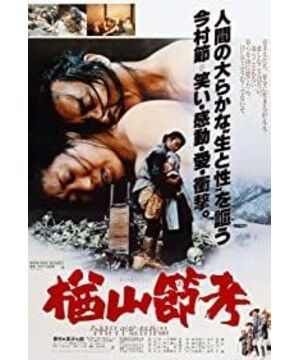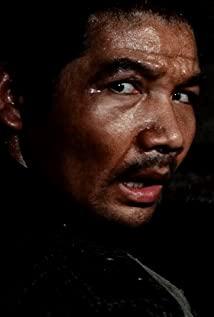Ever heard of the fact that if your parents are 70 years old, you have to carry your parents up a snowy mountain and leave them there to die? Then you're about to be blown away by the movie of this story. This is my first feeling after watching this movie, what is it? Does it talk about people, about human nature, faith, morality and ethics, human ethics and filial piety, motherhood or sex, society, criticism, and survival?
On the afternoon of the Beijing International Film Festival, I temporarily changed the film layout. Influenced by my friends, I had to watch it and told me that it was about sending my mother up the mountain when I was old. I did not hesitate to cancel the original film purchase. A series of new and old editions of "Narayama Festival Examination" have been published. Due to the suddenness of the incident, I only entered the theater half of the old version, and I don't know what it was about before. What I watched directly was the part of carrying my mother up the mountain, and I watched it with my eyes fixed. There is only one feeling in my heart. I have seen a sense of oppression, depression and shock that I have never seen in any movie. I went out to the theater and couldn't get out of the heavy and oppressive shadow after the sun was shining for half a day... I asked my friend in shock, "What is this playing?" It was precisely because I only watched the most important part of going up the mountain. The plot, I can more deeply sigh the intuitive impact of this movie! Next, I will also tell the two films in the form of a comparison between the old and the new.
The reason why I chose the new version, which is Imamura's 1983 film, is that it is the second complete film I've watched, and the film review will focus on it.
The two versions of the film are about a village in a remote and deep mountain, where people live in closed life. Because of poverty, they have developed a traditional and almost religious custom in order to save more food for their families. That is, when a person reaches the age of 70, the child must personally carry it on the back of Mt. Nara in the distance, and will be blessed by the god of Mt. Nara and live forever. Of course, we all know what the ending will be. But you won't understand how bleak this is, and how heart-wrenching and terrifying the power is when it becomes a belief. What country can produce such a storyline? At that time I walked out of the cinema and said, "Only Japan can make such a film."
Japan, as we all know, is a country with rapid economic development after World War II. After the end of World War II, the people have not stepped out of their shadows and developed rapidly, and the people's hearts have been released. People there respect each other, pay attention to etiquette, and are very self-disciplined. The streets are clean and tidy, and China is chaotic by comparison. But is that really what it looks like? The ongoing social problems have never been resolved, and the politics have always been uncertain and unstable, and Japan is still in chaos. The people there are deeply separated from each other. I have read a report of Chinese people living in Japan, working there for several months. Although they communicate normally with colleagues, they never touch each other's lives. They are more like familiar strangers who don't know each other. In the subway, people quietly do their own thing with each other. Although, if you ask them for directions, they will still enthusiastically help you, but this is more of an instinct. The same instinct is that they are all protecting themselves, consciously and regularly making a good circle between themselves and the outside world. Well, in such a social environment, people can also know from this that the materials used for filming there are often at the top of Asia and at the forefront of the world. It even has its own cognitive angle and height in ethical films. Japan is still the country with the highest suicide rate. The Japanese people are in danger on the island that will sink in the future, and they are careful to protect themselves and their families. Personally, Japan feels like it is at the forefront of human self-destruction.
What about the director who came out here? The first thing that came to mind was Akira Kurosawa. What is there to say about the name, the influence of this man is on the entire history of film. How many people imitate and learn from. Nagisa Oshima, Takeshi Kitano, Yasujiro Ozu, Hayao Miyazaki and the one who just won the Palme d'Or is Hirokazu-eda. The directors of these two films are two well-known directors, Kinoshita Keisuke and Imamura Shohei. Kinoshita Keisuke's films are usually soft and lyrical, and together with Akira Kurosawa and others are called the Four Horsemen, and their status is comparable to Akira Kurosawa in Japan. It was assigned to Yasujiro Ozu, who had different styles. Unexpectedly, in the future, the two will come together because of a story, "Narayama Festival Exam".
As soon as I walked into the theater and sat down to watch Director Kinoshita's work, I was attracted by the dark and brightly colored lighting, how wonderful. Then there is the construction of indoor studios that are often seen in Japan. It seems that the films are all completed in such a set, with bright lights, with the wind made by machines, etc. At first, I saw that the village was looking for a family who stole food. Punishment, I didn't understand it, and the next thing I did was to carry my mother up the mountain. From that moment on, my heart became tense, although I could guess that it was because of poverty. But I am still asking myself, why did I do this, my heart was so panicked that I could not describe it, I was deeply hooked by the strong and compact sound of the Japanese folk instruments, and I felt as if I walked towards Narayama with questions about human nature. ...Such paragraphs are combined with strong and profound background sound effects, suppressing the heart, and the strong sense of oppression is almost suffocating! This kind of film does not have the lyricism of director Kinoshita at all. Maybe the previous foreshadowing I didn't watch is a big vacancy, but the plot of the last mountain is enough for me to never erase it! The shadows left later can't fade away... This is a powerful force. As the camera rolls around, one mountain after another is climbed in the studio, until the drifting cold snow, the bone-filled Mt. Nara...
If watching the old version was my first impression of this storyline, then the next Imamura version is where I start to understand the story. The film and the Kinoshita version of the film are richer, and the content of the film has added more layers about village life, sex, animal metaphors, etc... That is, the film in the new era, and Kinoshita Keisuke focuses on the expression of stories and set lighting, which is more straightforward and concise. , until the hearts of the people are different. The film adds character stories, such as finding a daughter-in-law for his son, letting the second son who is not welcomed by the villagers taste the taste of sex, and enriching the plot of the story. Like a father who did not want to go to Mt. A new "sex" partner was found shortly after the pain of losing a partner, and the mother disappeared halfway through symbolic maneuvers. And some images of animals mating and food scraps are also some kind of symbolic metaphors for people. After World War II, Japan made sexuality public, and the people released their own pressure. As a result, Japan has always been in the forefront of ethics and morality, and has a deep understanding and cognition of sexuality. The little porn that we often talk about is endless. The director of this film, Imamura, is a director who likes to show the evil and bad side of human nature, which is the opposite of his mentor Yasujiro Ozu. This film is so straightforward and direct. A large number of sexual scenes, as well as obvious sexual themes, men kneel before women's private parts, and their understanding of sex and reproduction is respected and awe-inspiring. In addition, in order to die and not be haunted by evil spirits, he asked his spouse to mate with the males of the whole village once, which also showed human instinct and high worship of sex. After his grandson's wife was buried alive by the villagers, he was extremely sad, but he quickly found a new replacement. product, where the spouse is only a sex product, a tool for reproduction. Even the disgusting scene where the second son crosses with a white dog expresses the natural instinct and desire of human nature. When the last second son finally tasted the taste of sex, he accepted the request again and again to satisfy her old aunt's aging body. Release... These all profoundly express the director's unabashed love and understanding of sex. The film also focuses on explaining the living conditions of the villagers and the villagers' understanding of customs, where their lives are close to returning to the primitive. Husbands and wives are just to live together, there is no love, no need to get married, you can eat at our house if you work and reproduce. In the film, the granddaughter-in-law's family is often found stealing food from other people's homes. Unfortunately, they are caught alive by the neighbors in the village. The scene where all men, women and children are buried alive. In the film, the dead baby's body is found in the field and used by the villagers to fertilize. It is incomprehensible today, right? This
People in the village have followed traditions for years for survival and for food. In the 1958 edition, a man in Nakamura, because his father didn't want to go to Mt. Nara, tied his father and went up, and when his father resisted, he directly pushed his father down the valley! The mother also felt ashamed because she was too healthy and had a good appetite. It was a shame to be ridiculed in the village for her body that is now called a blessing. She even knocked out her own teeth and happily showed everyone... Before she left, her wish was to choose a good wife for her children, to make a good wife how to catch fish, to hand over her own affairs as inheritance, and to satisfy her youngest son's love for sex. The longing of the eldest son, he went up the mountain with no regrets... On the way, the mother did not say a word, just patted the eldest son on the shoulder to let him stop and rest, and move on. She never feared, but yearned. It's like a quest to meet your final baptism. So, what is the reason for this inhumanity now, poverty, food? This is the human nature that people make when they can't take care of themselves. This was captured by Imamura Shohei and bluntly magnified. People in this world are fragile species. When they are cornered and unable to survive, they will lose their current reason and eat each other, because people are inherently selfish. So what exactly is this film trying to talk about, maybe it should be to let us recognize who we really are.
Finally, after putting my mother on the desolate Mt. Nara, snow finally fell on the mountain, which means that the mountain god came to pick up my mother, and she has this qualification. The happy son ran back and shouted at his mother, and the mother's wish was fulfilled. And the mother waved her hand beside the piles of white bones, and closed her eyes with a satisfied smile in the cold snow... She left all the good things to her children in the future. This humanity may be the love that saves mankind in the end. .
View more about The Ballad of Narayama reviews











